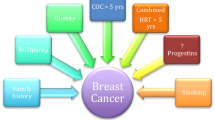Abstract
Objectives: To estimate the magnitude and persistence of the protective effect of use of combined oral contraceptives (COCs) and endometrial cancer risk.
Methods: We performed a nation-wide, population-based case–control study among postmenopausal women aged 50–74 years in Sweden, which included 709 subjects with incident, histopathologically verified endometrial cancer, and 3,368 controls with an intact uterus. We used unconditional logistic regression to calculate odds ratios as estimates of relative risks.
Results: Use of any sort of oral contraceptive decreased risk for endometrial cancer by 30%, while progestin-only pills reduced risk more markedly. For COCs the reduction in risk was noticeable following 3 or more years of use (OR 0.5, 95% CI 0.3–0.7), and increased with duration of intake, reaching 80% lower risk after 10 years of use. The protective effect of COC use was similar for all degrees of tumor differentiation and invasiveness, and remained for at least 20 years after cessation of use. Subsequent use of hormone replacement did not modify these protective effects.
Conclusions: We conclude that COC use confers a long-lasting protection against endometrial cancer risk which is particularly marked for long-term users.
Similar content being viewed by others
References
International Agency for Research on Cancer (1999) Some Hormones, Postmenopausal Hormone Therapy, and Hormonal Contraception. Lyon: IARC Monograph on the evaluation of carcinogenic risks to humans, vol. 72 (in press).
Breslow NE, Day NE (1980) Statistical Methods in Cancer Research. vol. 1: The Analysis of Case-Control Studies. Lyon: International Agency for Research on Cancer, pp. 192-246.
Weiderpass E, Baron JA, Adami HO, et al. (1999) Low potency estrogen formulations and risk for endometrial cancer. Lancet (in press).
Gray LA Sr, Christopherson WM, Hoover RN (1977) Estrogens and endometrial carcinoma. Obstet Gynecol 49: 385-389.
Weiss NS, Sayvetz TA (1980) Incidence of endometrial cancer in relation to the use of oral contraceptives. N Engl J Med 302: 551-554.
Kaufman DW, Shapiro S, Slone D, et al. (1980) Decreased risk of endometrial cancer among oral contraceptive users. N Engl J Med 303: 1045-1048.
Hulka BS, Chambless LE, Kaufman DG, Fowler WC Jr, Greenberg BG (1982) Protection against endometrial carcinoma by combination-product oral contraceptives. JAMA 247: 475-477.
Kelsey JL, Livolsi VA, Holford TR, et al. (1982) A case-control study of cancer of the endometrium. Am J Epidemiol 116: 333-342.
La Vecchia C, Francheschi S, Decarli A, Gallus G, Tognoni G (1984) Risk factors for endometrial cancer in different ages. J Natl Cancer Inst 73: 667-671.
La Vecchia C, Decarli A, Fasoli M, et al. (1986) Oral contraceptives and cancers of the breast and of the female genital tract: interim results from a case-control study. Br J Cancer 54: 311-317.
Pettersson B, Adami H-O, Bergström R, Johansson EDB (1986) Menstruation span — a time-limited risk factor for endometrial cancer. Acta Obstet Gynecol Scand 65: 247-255.
Centers for Disease Control and the National Institute of Child Health and Human Development (1987) The Cancer and Steroid Hormone Study. Combination oral contraceptive use and the risk of endometrial cancer. JAMA 257: 796-800.
World Health Organization (WHO) Collaborative Study of Neoplasia and Steroid Contraceptives (1988) Endometrial cancer and combined oral contraceptives. Int J Epidemiol 17: 263-269.
Koumantaki Y, Tzonou A, Koumantakis E, Kaklamani E, Aravantinos D, Trichopoulos D (1989) A case-control study of cancer of endometrium in Athens. Int J Cancer 43: 795-799.
Levi F, La Vecchia C, Gulie C, et al. (1991) Oral contraceptives and the risk of endometrial cancer. Cancer Causes Control 2: 99-101.
Rosenblatt KA, Thomas DB (1991) The WHO Collaborative Study of Neoplasia and Steroid Contraceptives. Hormonal content of combined oral contraceptives in relation to the reduced risk of endometrial cancer. Int J Cancer 49: 870-874.
Shu XO, Brinton LA, Zheng W, Gao YT, Fan J, Fraumeni JF Jr (1991) A population-based case-control study of endometrial cancer in Shanghai, China. Int J Cancer 19: 38-43.
Jick SS, Walker AM, Jick H (1993) Oral contraceptives and endometrial cancer. Obstet Gynecol 82: 931-935.
Stanford JL, Brinton LA, Berman ML, et al. (1993) Oral contraceptives and endometrial cancer: do other risk factors modify this association? Int J Cancer 54: 243-248.
Voigt LF, Deng Q, Weiss NS (1994) Recency, duration, and progestin content of oral contraceptives in relation to the incidence of endometrial cancer. Cancer Causes Control 5: 227-233.
Vessey MP, Painter R (1995) Endometrial and ovarian cancer and oral contraceptives — findings in a large cohort study. Br J Cancer 71: 1340-1332.
Henderson BE, Casagrande JT, Pike MC, Mack T, Rosario I, Duke A (1983) The epidemiology of endometrial cancer in young women. Br J Cancer 47: 749-756.
Key TJA, Beral V (1992) Sex hormones and cancer. In: Vainio H, Magee PN, McGregor DB, Mc Michel AJ, eds. Mechanisms of Carcinogenesis in Risk Identification. Lyon: International Agency for Research on Cancer, pp. 225-269.
Gurpide E. (1991) Endometrial cancer: biochemical and clinical correlates. J Natl Cancer Inst 83: 405-416.
Hsueh AJ, Peck EJ Jr, Clark JH (1975) Progesterone antgonism of the oestrogen receptor and estrogen-induced uterine growth. Nature 254: 337-339.
Tseng L, Gurpide E (1975) Effects of progestins on estradiol receptor levels in human endometrium. J Clin Endocrinolol Metab 41: 402-404.
Graham JD, Clarke CL (1997) Physiological action of progesterone in target tissues. Endocrinol Rev 18: 502-519.
Grady D, Gebretsadik T, Ernster V, Pettiti D (1995) Hormone replacement therapy and endometrial cancer risk: a meta-analysis. Obstet Gynecol 85: 304-313.
Beresford SA, Weiss NS, Voigt LF, McKnight B (1997) Risk of endometrial cancer in relation to use of estrogen combined cyclic progestagen therapy in postmenopausal women. Lancet 349: 458-461.
Author information
Authors and Affiliations
Additional information
(institution where the work has been performed)
Rights and permissions
About this article
Cite this article
Weiderpass, E., Adami, HO., Baron, J.A. et al. Use of oral contraceptives and endometrial cancer risk (Sweden). Cancer Causes Control 10, 277–284 (1999). https://doi.org/10.1023/A:1008945721786
Issue Date:
DOI: https://doi.org/10.1023/A:1008945721786




